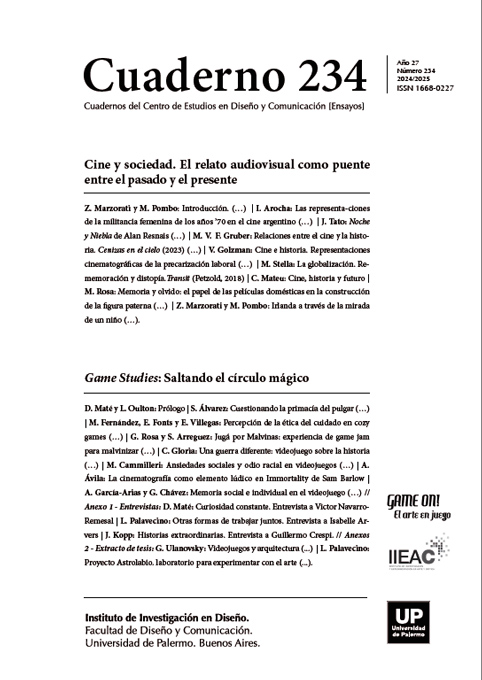Cuestionando la primacía del pulgar. La estética de la inacción en los videojuegos contemplativos
Résumé
Este artículo propone una tipología de “videojuegos contemplativos” que limitan considerablemente la interactividad y no requieren la participación activa por parte del usuario, lo que desencadena una serie de cualidades únicas.
Références
Aarseth, E. J. (1997). Cybertext: Perspectives on Ergodic Literature. The Johns Hopkins University Press.
Alharthi, S. A., Alsaedi, O., Toups, Z. O., Tanenbaum, T. J., & Hammer, J. (2018). Playing to Wait: A Taxonomy of Idle Games. En CHI ’18: Proceedings of the 2018 CHI Conference on Human Factors in Computing Systems. https://doi.org/10.1145/3173574.3174195
Alpañés, E. (12 de marzo de 2023). El ‘slow gaming’ o cómo los videojuegos están cambiando los disparos y la tensión por agradables paseos. El País. https://elpais.com/estilo-de-vida/2023-03-12/el-slow-gaming-o-como-los-videojuegos-estan-cambiandolos-disparos-y-la-tension-por-agradables-paseos.html
Anthropy, A. (2012). Rise of the videogame Zinesters: How Freaks, Normals, Amateurs, Artists, Dreamers, Drop-outs, Queers, Housewives, and People Like You Are Taking Back an Art Form. Seven Stories Press.
Atkinson, P., & Parsayi, F. (2021). Video Games and Aesthetic Contemplation. Games and Culture, 16(5), 519-537. https://doi.org/10.1177/1555412020914726
Carbo-Mascarell, R. (2016). Walking Simulators: The Digitisation of an Aesthetic Practice. En DiGRA/FDG ’16 - Proceedings of the First International Joint Conference of DiGRA and FDG (Vol. 13). http://www.digra.org/wp-content/uploads/digital-library/paper_66.pdf
Crawford, C. (1984). The Art of Computer Game Design. Osborne/McGraw-Hill.
De Paoli, S. (2013). Automatic-Play and Player Deskilling in MMORPGs. Game Studies, 13(1). http://gamestudies.org/1301/articles/depaoli_automatic_play
Fizek, S. (2018a). Automated State of Play: Rethinking Anthropocentric Rules of the Game. Digital Culture & Society, 4(1), 201-214.
Fizek, S. (2018b). Interpassivity and the Joy of Delegated Play in Idle Games. Transactions of the Digital Games Research Association, 3(3), 137-163. https://doi.org/10.26503/todigra.v3i3.81
Fizek, S. (2018c). Automation of play: Theorizing self-playing games and post-human ludic agents. Journal Of Gaming & Virtual Worlds, 10(3), 203-218. https://doi.org/10.1386/jgvw.10.3.203_1
Fizek, S. (2022). Playing at a Distance: Borderlands of Video Game Aesthetic. The MIT Press.
Galloway, A. R. (2006). Gaming: Essays on Algorithmic Culture. University of Minnesota Press.
Hjorth, L., & Richardson, I. (2014). Gaming in Social, Mobile and Locative Media. Palgrave MacMillan.
Hjorth, L., & Richardson, I. (2020). Ambient Play. The MIT Press.
Jenkins, H. (2004). Game Design as Narrative Architecture. En N. Wardrip-Fruin & P. Harrigan (Eds.), First Person: New Media as Story, Performance, and Game (pp. 118-130). The MIT Press.
Juul, J. (2003). The Game, the Player, the World: Looking for a Heart of Gameness. En M. Copier & J. Raessens (Eds.), DiGRA ’03 - Proceedings of the 2003 DiGRA International Conference: Level Up (Vol. 2). Utrecht University. http://www.digra.org/wp-content/uploads/digital-library/05163.50560.pdf
Juul, J. (2010). A casual revolution: Reinventing Video Games and Their Players. The MIT Press.
Juul, J. (13-15 de agosto de 2018). The Aesthetics of the Aesthetics of the Aesthetics of Video Games: Walking Simulators as Response to the problem of Optimization. En 12th International Conference on the Philosophy of Computer Games Conference, Copenhague. https://www.jesperjuul.net/text/aesthetics3/
Kagen, M. (2022). Wandering games. The MIT Press.
Keogh, B., & Richardson, I. (2018). Waiting to play: The labour of background games. European Journal of Cultural Studies, 21(1), 13-25. https://doi.org/10.1177/1367549417705603
Leino, O. T. (2013). Playability and its Absence – A post-ludological critique. DiGRA ’13 - Proceedings Of The 2013 DiGRA International Conference: DeFragging Game Studies. http://www.digra.org/wp-content/uploads/digital-library/paper_263.pdf
O’Brien, N. (29 octubre de 2013). Lingering Patience. Rhizome. https://rhizome.org/editorial/2013/oct/29/lingering-patience/
Pedercini, P. (5 noviembre de 2020). Games Without Players. 2020 Play Festival, Hamburgo, Alemania. https://www.molleindustria.org/blog/games-without-players/
Ruffino, P. (2020). Nonhuman Games: Playing in the Post-Anthropocene. En M. CowardGibbs (Ed.), Death, Culture and Leisure: Playing Dead (pp. 11-25). Emerald. https://doi.org/10.1108/978-1-83909-037-020201008
Salen, K., & Zimmerman, E. (2003). Rules of Play: Game Design Fundamentals. The MIT Press.
Samyn, M. (19 marzo de 2010). Not a manifesto. Notgames blog. http://notgames.org/blog/2010/03/19/not-a-manifesto/
Scully-Blaker, R. (2016). Re-Curating the Accident: Speedrunning as Community and Practice [tesis de maestría]. Concordia University.
Scully-Blaker, R. (2018). Stasis and Stillness: Moments of Inaction in Videogames. En DiGRA ’18 - Proceedings of the 2018 DiGRA International Conference: The Game is the Message. http://www.digra.org/wp-content/uploads/digital-library/DIGRA_2018_Paper_1.pdf
Walker, J. (12 diciembre de 2022). One of Steam’s Most Popular Games Is About Watching Rubber Duckies Float. Kotaku. https://kotaku.com/steam-pc-valve-reviews-placidplastic-duck-simulator-1849881803
Zhou, X. (2023). An Exploration of Interactions and Design Implications of Low-interactivity Games [tesis de maestría]. Uppsala Universitet.
Los autores/as que publiquen en esta revista ceden los derechos de autor y de publicación a "Cuadernos del Centro de Estudios de Diseño y Comunicación", Aceptando el registro de su trabajo bajo una licencia de atribución de Creative Commons, que permite a terceros utilizar lo publicado siempre que de el crédito pertinente a los autores y a esta revista.


